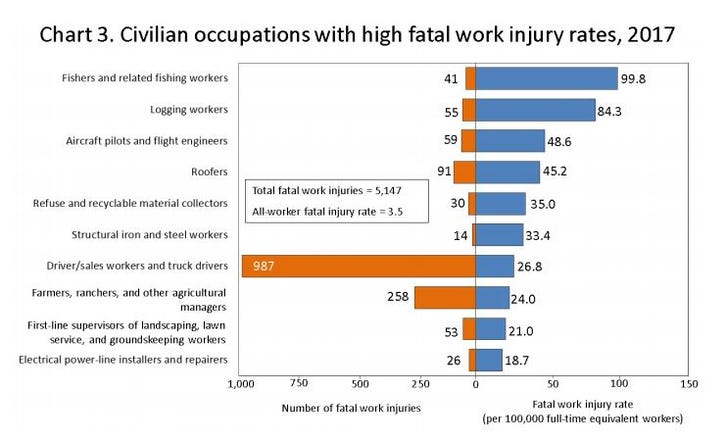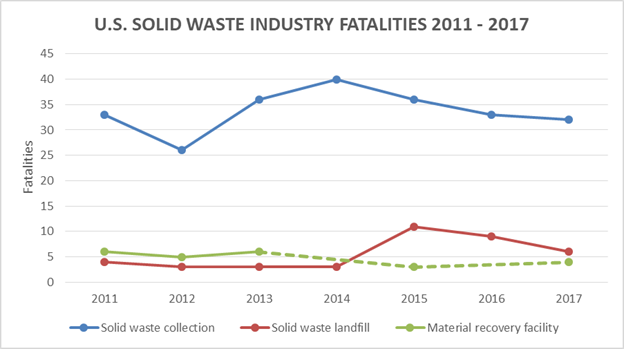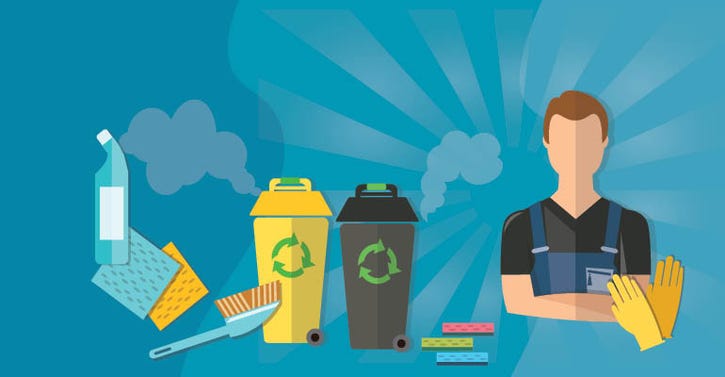Waste and Recycling Industry Fatalities Down Slightly in 2017
BLS reports fatalities in the public and private waste and recycling industry declined from 31 in 2016 to 30 in 2017.

The Bureau of Labor Statistics (BLS) has published its annual review of fatal occupational injuries, which reveals that fatalities of all U.S. workers remained flat in 2017. In the public and private waste and recycling industry, fatalities declined slightly from 31 in 2016 to 30 in 2017. However, the fatal work injury rate increased in 2017 from 34.1 to 35.0 per 100,000 full-time equivalent workers.
“This should encourage our industry to continue its commitment to the organizational programs implemented over the past year to strengthen the culture of safety,” said Darrell Smith, president and CEO of the National Waste & Recycling Association (NWRA), in a statement. “The National Waste & Recycling Association and our members won’t stop looking for opportunities to improve, and we will never accept any loss. Zero is possible.”
Despite this slight decrease in fatalities, the occupation of refuse and recyclable material collector remains the fifth most dangerous private sector job in the U.S. This is not where the industry wants to be, and industry leaders are continuing their efforts to make the waste and recycling industry safer.

Photo courtesy of BLS
“We are not surprised by the disappointing 2017 results, as SWANA tracks all worker and third-party fatal incidents in the United States and Canada involving the solid waste industry,” said David Biderman, executive director and CEO of the Solid Waste Association of North America (SWANA), in a statement. “Solid waste collection continues to be the fifth most dangerous job in America, with a higher workplace fatality rate than police officers or firefighters.”
“SWANA’s preliminary data also indicates an increase in the number of worker fatalities in 2018, with nearly 50 solid waste employee fatalities recorded through December 15, 2018,” added Biderman.
Deaths among landfill employees (NAICS 562212), which are part of the reported industry total, have decreased in recent years, from nine deaths in 2015 to six deaths in 2017. There were also four fatalities among materials recovery facility (MRF) workers (NAICS 562920) in 2017. In 2016, MRF data didn’t meet BLS publication criteria.

Photo courtesy of SWANA
To improve safety within the industry and reduce the number of incidents and injuries that occur, leaders are enhancing and expanding programs; hosting seminars, webinars and education sessions; providing more training and developing safety manuals; utilizing more technology; hosting commercial vehicle safety inspection briefings and demonstrations; and helping to propose and pass new regulation and legislation like the Slow Down to Get Around legislation, which is now the law in 22 states. The law, which requires motorists to slow down and safely move over when approaching certain vehicles on the roadway, is supported by NWRA, SWANA and others.
Industry leaders are also focusing on ramping up the conversation around distracted driving, which is a danger to workers and civilians alike.
“Carmakers should make it their goal to reduce distractions in the car. You shouldn’t be able to order dinner from your car’s infotainment center,” said Kirk Sander, vice president of safety and standards at NWRA, in a statement. “As we continue to make our industry safer, we urge the motoring public to keep your eyes on the road and hands on the wheel.”
Additionally, SWANA is focusing on providing solid waste haulers that dump loads at disposal facilities across North America with proper safety tools. Earlier this year, the association released a Hauler Safety Toolkit, which features valuable safety resources in a simple, shareable form that SWANA Chapters now use at Hauler Safety Outreach events. These one-day events are designed to get safety messaging directly into the hands of drivers when they bring material to landfills, transfer stations, waste-to-energy (WTE) facilities, MRFs and other sites.
“The leaders in this industry have trouble reaching the small haulers with safety messages because small haulers aren’t typically members of any national association,” Biderman told Waste360. “Over the last few years, there has been an increasing percentage of fatal accidents of collection workers involving small haulers, and to help reduce that percentage, SWANA decided to think outside the box and develop a toolkit that would help small haulers and others communicate better and become more in-tune with industry best practices. This is our most significant new safety initiative for 2018, and we are pleased that many of the larger companies in the industry that own majority of landfills, transfer stations, WTE facilities and MRFs have agreed to participate. We are offering this free toolkit to SWANA members and nonmembers because safety is that important, and there needs to be an ongoing conversation about safety in this industry.”

In addition to utilizing the free toolkit, SWANA is encouraging haulers to take the SWANA Safety Pledge to commit to consider worker, customer and public safety in every decision that they make.
“To that end, the Florida SWANA Sunshine Chapter will be hosting a three-day Safety Matters symposium this March,” said Chad Grecsek, director of recycling and solid waste management and SWANA South Florida safety ambassador, in a statement. “This conference is being held in coordination with the chapter’s annual Road-E-O event and will bring collection and facilities managers as well as public and private sector leaders together to tackle this very important issue. Sessions will focus on the latest trends, lessons learned and disseminate proven safety best management practices. Our best drivers with impeccable safety records will share their daily approaches to safety. The latest safety equipment and technologies will also be discussed.”
Looking forward to 2019, safety will remain top of mind for the industry, as everyone works together to reduce the number of injuries and incidents that occur and ensure all employees make it home safe every day.
About the Author
You May Also Like




